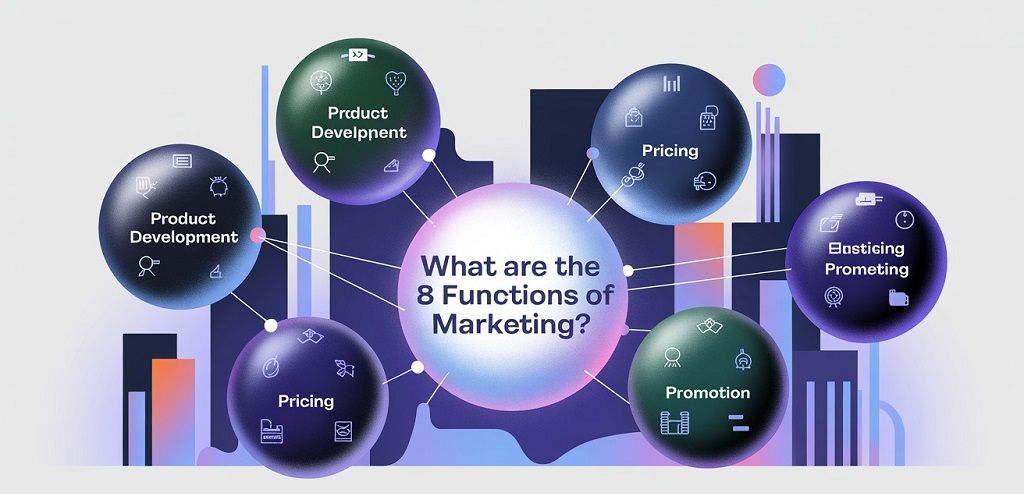
What Are the 8 Functions of Marketing? Definitions & Real-World Examples
Marketing forms the backbone of every successful business. Companies rely on strategic marketing approaches to connect with customers and drive growth. Understanding the core functions helps businesses create effective campaigns that deliver results. Heygom provides valuable insights into how these marketing principles work in practice.
Modern businesses face intense competition in today’s marketplace. Therefore, companies must master multiple marketing functions to stay ahead. Each function plays a specific role in the customer journey. Additionally, these functions work together to create a comprehensive marketing strategy.
Many business owners wonder what are the 8 functions of marketing? and how they apply to their industry. These functions provide a framework for understanding how products move from creation to consumer. Furthermore, they help businesses identify areas for improvement in their marketing efforts.
The Eight Core Functions of Marketing
-
Market Information Management
Market information management involves collecting and analyzing data about customers, competitors, and market trends. Companies use this information to make informed decisions about their products and services. However, gathering data is only the first step in this process.
Successful businesses analyze customer behavior patterns to understand purchasing decisions. They track social media engagement, website analytics, and sales data. Additionally, they monitor competitor activities to identify market opportunities.
Amazon excels at market information management through its recommendation system. The company analyzes millions of customer interactions daily. Therefore, they can predict what products customers might want next. This approach has helped Amazon become one of the world’s largest retailers.
-
Product and Service Planning
Product and service planning focuses on developing offerings that meet customer needs. This function includes researching market demands and creating solutions. Companies must balance customer wants with business capabilities and resources.
The planning process starts with identifying market gaps or unmet needs. Businesses then develop products or services to fill these gaps. Furthermore, they must consider pricing, features, and positioning during the planning phase.
Apple demonstrates excellent product planning with its iPhone releases. The company conducts extensive research before launching new models. Additionally, Apple considers customer feedback and technological advances in their planning process. This approach has made the iPhone one of the most successful product lines in history.
-
Buying and Purchasing
Buying and purchasing involves acquiring goods and services for resale or business operations. Companies must select suppliers, negotiate prices, and manage inventory levels. This function directly impacts product availability and profitability.
Effective purchasing requires strong supplier relationships and market knowledge. Businesses must evaluate quality, price, and delivery terms when making purchasing decisions. Therefore, companies often develop long-term partnerships with reliable suppliers.
Walmart excels in purchasing through its massive scale and negotiating power. The company works directly with manufacturers to secure low prices. Additionally, Walmart uses advanced forecasting to optimize inventory levels. This approach allows them to offer competitive prices to customers.
-
Transportation and Storage
Transportation and storage ensure products reach customers when and where needed. This function includes warehousing, inventory management, and logistics coordination. Companies must balance storage costs with product availability requirements.
Efficient transportation reduces costs and improves customer satisfaction. Businesses must choose appropriate shipping methods for different products and destinations. Furthermore, they need reliable storage facilities to maintain product quality and availability.
FedEx revolutionized transportation in marketing with its overnight delivery service. The company created a hub-and-spoke system that maximizes efficiency. Therefore, FedEx can deliver packages quickly across vast distances. This innovation transformed customer expectations for shipping speed.
-
Grading and Standardization
Grading and standardization involve establishing quality standards and sorting products accordingly. This function helps customers make informed purchasing decisions. Additionally, it ensures consistent quality across product lines and different production batches.
Companies develop grading systems based on various factors like size, quality, and features. These standards help streamline operations and reduce confusion. However, businesses must communicate these standards clearly to customers and partners.
The USDA grading system for beef provides an excellent example of standardization in action. Restaurants and consumers rely on these grades to select appropriate products. Therefore, the system creates trust and consistency throughout the supply chain.
-
Selling and Promotion
Selling and promotion involve communicating product benefits and persuading customers to make purchases. This function includes advertising, personal selling, and promotional campaigns. Companies must craft messages that resonate with their target audiences.
Effective promotion requires understanding customer motivations and preferred communication channels. Businesses use various media to reach different customer segments. Additionally, they must measure promotional effectiveness to optimize their efforts.
Nike’s “Just Do It” campaign exemplifies powerful selling and promotion. The company created an emotional connection with athletes and fitness enthusiasts. Furthermore, Nike used consistent messaging across multiple channels to reinforce their brand identity.
-
Pricing Strategy
Pricing strategy determines how much customers pay for products or services. This function requires balancing profitability with competitive positioning and customer value perception. Companies must consider costs, competition, and market demand when setting prices.
Successful pricing strategies reflect the value customers receive from products or services. Businesses may use different pricing approaches for various market segments. Therefore, companies often test different price points to find optimal levels.
Tesla uses premium pricing to position its vehicles as luxury products. The company emphasizes innovation and environmental benefits to justify higher prices. Additionally, Tesla’s pricing strategy helps fund research and development for future products.
-
Risk Management
Risk management involves identifying and mitigating potential threats to marketing success. This function includes financial risks, market changes, and operational challenges. Companies must develop contingency plans to address various scenarios.
Effective risk management requires continuous monitoring of internal and external factors. Businesses must assess the probability and impact of different risks. Furthermore, they need strategies to minimize negative consequences when problems occur.
McDonald’s demonstrates excellent risk management through menu diversification. The company adapts offerings to local tastes and dietary trends. Therefore, McDonald’s reduces dependence on any single product category while meeting diverse customer needs.

How These Functions Work Together
The eight functions of marketing operate as an interconnected system rather than isolated activities. Market information management informs product planning decisions. Additionally, transportation and storage capabilities influence pricing strategies and promotional timing.
Successful companies coordinate these functions to create seamless customer experiences. They align purchasing decisions with promotional campaigns and pricing strategies. Furthermore, they use risk management principles to protect all marketing investments.
Integration becomes especially important during product launches or market expansion. Companies must synchronize multiple functions to maximize success opportunities. Therefore, businesses often use project management tools to coordinate marketing activities.
Implementing the Eight Functions in Your Business
Small businesses can apply these functions regardless of their size or industry. They should start by assessing their current capabilities in each area. Additionally, they can prioritize improvements based on customer needs and business goals.
Companies should invest in systems and processes that support multiple functions simultaneously. For example, customer relationship management software helps with market information and selling functions. Therefore, businesses can achieve greater efficiency through integrated solutions.
Regular evaluation ensures that marketing functions continue meeting business objectives. Companies should measure performance and adjust strategies based on results. Furthermore, they must stay current with changing customer expectations and market conditions.
Read More Also: How to write a tech brand PR strategy
Conclusion
The eight functions of marketing provide a comprehensive framework for business success. Companies that master these functions create competitive advantages in their markets. Market information management guides strategic decisions, while product planning ensures customer satisfaction.
Transportation, grading, and purchasing functions support operational excellence. Additionally, selling, promotion, and pricing strategies drive revenue growth. Risk management protects investments and ensures long-term sustainability.
Businesses should view these functions as interconnected elements of a complete marketing system. Success requires coordination and integration across all functions. Therefore, companies that excel in marketing treat these functions as equally important components of their strategy.
Understanding and implementing these eight functions helps businesses build stronger customer relationships and achieve sustainable growth. Whether you’re a startup or established company, these principles remain relevant for marketing success.
Read More Also: The Best Online Platforms to Buy Arduino Accessories in the USA
Frequently Asked Questions
What are the most important functions of marketing for small businesses?
Market information management and selling/promotion are typically most critical for small businesses. These functions help understand customer needs and communicate value effectively. Additionally, pricing strategy significantly impacts profitability for smaller companies.
How do the 8 functions of marketing differ from the 4 Ps of marketing?
The 8 functions focus on operational activities and processes, while the 4 Ps (Product, Price, Place, Promotion) represent strategic elements. The functions describe what businesses do, whereas the 4 Ps describe what they decide. However, both frameworks complement each other in comprehensive marketing planning.
Can businesses succeed by focusing on only some of these functions?
While businesses might excel in certain functions, neglecting others creates weaknesses competitors can exploit. All eight functions contribute to marketing success in different ways. Therefore, companies should strive for competence across all functions while building expertise in their most critical areas.
How has technology changed these traditional marketing functions?
Technology has enhanced efficiency and effectiveness across all functions. Digital tools provide better market information, streamline purchasing, and improve customer communication. Additionally, e-commerce platforms integrate multiple functions into single systems. However, the fundamental purposes of these functions remain unchanged.
What skills do marketing professionals need to manage these functions effectively?
Marketing professionals need analytical skills for market information and risk management. Communication skills are essential for selling and promotion functions. Additionally, they need strategic thinking abilities to coordinate multiple functions effectively. Project management skills help ensure successful implementation across all areas.




